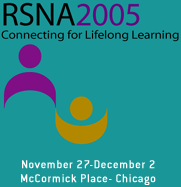
Abstract Archives of the RSNA, 2005
SSC05-05
Sixty-Four-slice Computed Tomography in the Diagnosis of Ischemic Heart Disease: Impact on Clinical Decision-making
Scientific Papers
Presented on November 28, 2005
Presented as part of SSC05: Cardiac (Multimodality)
Konstantin Nikolaou MD, Presenter: Nothing to Disclose
Bernd Juergen Wintersperger MD, Abstract Co-Author: Nothing to Disclose
Carsten Rist MD, Abstract Co-Author: Nothing to Disclose
Thorsten Ralph Christopher Johnson MD, Abstract Co-Author: Nothing to Disclose
Maximilian Ferdinand Reiser MD, Abstract Co-Author: Nothing to Disclose
Christoph Richard Becker MD, Abstract Co-Author: Nothing to Disclose
Andreas Knez MD, Abstract Co-Author: Nothing to Disclose
et al, Abstract Co-Author: Nothing to Disclose
The aim of this study was to compare the potential clinical value of a new generation of 64-slice Computed Tomography (64SCT) systems with that of invasive coronary angiography in the diagnosis of coronary artery disease (CAD).
50 consecutive patients with known or suspected CAD underwent both 64SCT and quantitative X-ray coronary angiography (QCA). A CT system with 32 detector-rows and acquisition of 64 slices per gantry rotation was employed, with a spatial resolution of 0.4x0.4x0.4 mm and a temporal resolution of 83-165 ms (Somatom Sensation 64, Siemens Medical Solutions, Forchheim, Germany). Sensitivity, specificity and diagnostic accuracy of 64SCT in the detection or exclusion of significant CAD were evaluated on a per-patient and per-segment basis.
47 of 50 coronary CT angiograms (94%) were of diagnostic image quality. Reasons for non-assessability were breathing artefacts (n=1) and tachyarrhythmia (n=2). QCA demonstrated significant CAD in 45% (21/47) and non-significant disease or normal coronary angiograms in 55% (26/47) of the patients. Sensitivity, specificity, diagnostic accuracy and negative predictive value (NPV) of 64SCT on a per-patient basis were 95%, 81%, 87% and 95%. On a per segment basis, 519 of 600 coronary artery segments were assessable (87%). For the detection of significant stenoses on a per-segment basis 64SCT showed a sensitivity, specificity, diagnostic accuracy and NPV of 83%, 97%, 95% and 99%, respectively.
64SCT coronary angiography provides a significantly increased spatial and temporal resolution as compared to earlier MSCT systems. These benefits hold great promise for the reliable diagnosis or exclusion of significant CAD in a clinical setting and could give CTA an important role in the stratification of patients with known or suspected CAD.
Nikolaou, K,
Wintersperger, B,
Rist, C,
Johnson, T,
Reiser, M,
Becker, C,
Knez, A,
et al, ,
Sixty-Four-slice Computed Tomography in the Diagnosis of Ischemic Heart Disease: Impact on Clinical Decision-making. Radiological Society of North America 2005 Scientific Assembly and Annual Meeting, November 27 - December 2, 2005 ,Chicago IL.
http://archive.rsna.org/2005/4412550.html

